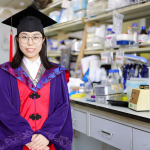Yanfei Zhang: Plant Physiology First Author

 Yanfei Zhang, first author of “Wheat TaSnRK2.10 phosphorylates TaERD15 and TaENO1 and confers drought tolerance when overexpressed in rice”
Yanfei Zhang, first author of “Wheat TaSnRK2.10 phosphorylates TaERD15 and TaENO1 and confers drought tolerance when overexpressed in rice”
Current Position: Ph D candidate in Henan Agricultural University, Zhengzhou, China.
Education: Ph D candidate (Henan Agricultural University, Zhengzhou, China), Master of Agriculture (Henan Agricultural University, Zhengzhou, China), Bachelor of Agriculture (Henan Agricultural University, Zhengzhou, China).
Non-scientific Interests: Playing badminton, travelling, climbing mountain
Brief bio: As a Ph D student of Henan Agricultural University, I have the honor to join Dr. Mao Xinguo’s team at the Institute of Crop Sciences, Chinese Academy of Agricultural Sciences. My researches mainly focus on drought tolerance in wheat. We identified and characterized a key drought response gene TaSnRK2.10 with omics and molecular biological methods. Our data showed that TaSnRK2.10 acts as a positive regulator in the response to drought stress at different levels. TaSnRK2.10 was induced by multiple abiotic stresses and phytohormones. Ectopic expression of TaSnRK2.10 confers enhanced drought tolerance in rice, manifested by multiple improved physiological indices, including increases in water content, cell membrane stability, and survival rates, as well as decreases in water loss and accumulation of H2O2 and malonaldehyde. TaSnRK2.10 interacts with and phosphorylates TaERD15 (Early Responsive to Dehydration 15) and TaENO1 (Enolase 1) in vivo and in vitro. Overexpression of TaERD15 causes sensitivity to drought stress. TaERD15 phosphorylated by TaSnRK2.10 is prone to degradation by the 26S proteasome, thereby mitigating its negative effects on drought tolerance. Ectopic expression of TaSnRK2.10 results in a significant increase of phosphoenolpyruvate (PEP), a key metabolite of primary and secondary metabolism in transgenic plants, thereby enhancing their viability under drought stress. Our results demonstrate that TaSnRK2.10 not only regulates stomatal aperture and the expression of drought-responsive genes, but also enhances PEP supply and promotes the degradation of TaERD15, all of which enhance drought tolerance.
All co-authors and I are sincerely delightful and honored that our work was accepted to be published in Plant Physiology.
姓名:张艳菲
目前职位:河南农业大学在读博士研究生
教育经历:博士研究生(河南农业大学),农学硕士研究生(河南农业大学),农学学士(河南农业大学)
兴趣爱好:羽毛球、旅游、爬山
个人简介:作为河南农业大学王晨阳研究员团队的博士研究生,有幸加入到中国农业科学院作物科学研究所毛新国研究员团队学习,从事小麦抗旱基因发掘和作用机理解析工作。基于转录组分析我们克隆了小麦拔节期关键干旱应答基因TaSnRK2.10,综合运用多组学和分子生物学研究方法,证明TaSnRK2.10是一个干旱应答正向调节因子,参与ABA依赖和非ABA依赖的信号通路,通过不同机制,从不同水平调控抗旱性:(1)通过调节气孔开度、减少叶片水分散失,增强叶片保水能力,提高转基因水稻的抗旱性;(2)通过减少活性氧产生,提高抗氧化物质如抗坏血酸、还原态谷胱甘肽含量,降低MDA含量,减少细胞损伤,增强细胞膜稳定性,提高抗旱性;(3)干旱条件下通过降低转基因水稻基础代谢水平,增加能量和碳代谢中间物质磷酸烯醇式丙酮酸(PEP)的含量,促进抗氧化物质的合成,提高抗旱性;(4)通过磷酸化干旱应答负调控因子TaERD15,促进其经26S蛋白酶体途径降解,从而缓解TaERD15的负面影响。
我和我的合作者为这篇文章发表在Plant Physiology上感到由衷地高兴和荣幸。



